Scientists may have found a way to ‘de-age the brain’: Switching off certain immune cells could delay the onset of Alzheimer’s disease, cancer and heart disease, study finds
- Myeloid cells are found in the brain and serve a key role in removing dead cells
- As we age, our myeloid cells begin to dysfunction, inflicting damage to tissues
- But stopping a hormone from binding to these cells can ‘de-age’ the brain
- Findings could help drug makers to develop a compound to delay ageing
From brain-training apps to botox, many people will try anything to turn back the clock.
But a new study suggests that the key to slowing the ageing process could lie with certain cells in our immune system, called myeloid cells.
These cells play a vital role in fighting off infections and cleaning up debris, but they often go into overdrive as we age, causing chronic inflammation.
The research indicates that switching these cells off could ‘de-age’ the brain and delay the onset of several conditions, including heart disease, Alzheimer’s disease, cancer and frailty.
While the findings are very early stage, the researchers hope they could help drug makers to develop a compound to delay ageing.
Research indicates that switching myeloid cells off could ‘de-age’ the brain and delay the onset of several conditions, including heart disease, Alzheimer’s diseases, cancer and frailty (stock image)
WHAT ARE MYELOID CELLS?
Myeloid cells are found in the brain, the circulatory system and peripheral tissues, where they serve an essential role in cleaning up dead cells, providing nutrients to other cells, and watching out for invading pathogens.
However, as we age, our myeloid cells begin to dysfunction, inflicting damage to innocent tissues in the process.
In the study, the researchers blocked the interaction of a hormone called PGE2 and a receptor on myeloid cells in the mice and human cells in culture.
Amazingly, this was enough to restore youthful metabolism, and restore age-related mental decline in old mice.
In the study, researchers from Stanford Medicine studied myeloid cells in old mice, as well as myeloid cells in cultures from people older than 65 and under 35.
Myeloid cells are found in the brain, the circulatory system and peripheral tissues, where they serve an essential role in cleaning up dead cells, providing nutrients to other cells, and watching out for invading pathogens.
However, as we age, our myeloid cells begin to malfunction, inflicting damage to innocent tissues in the process.
In the study, the researchers blocked the interaction of a hormone called PGE2 and a receptor on myeloid cells in the mice and human cells in culture.
Amazingly, this was enough to restore youthful metabolism, and restore age-related mental decline in old mice.
Professor Katrin Andreasson, professor of neurology and neurological sciences and senior author of the study, explained: ‘If you adjust the immune system, you can de-age the brain.’
PGE2 is a hormone that belongs to a group known as prostaglandins, and does many different things in the body, depending on which cells it binds to.
For example, when PGE2 binds to a receptor called EP2 on myeloid cells, it initiates inflammatory activity inside the cells.
Myeloid cells are found in the brain, the circulatory system and peripheral tissues, where they serve an essential role in cleaning up dead cells, providing nutrients to other cells, and watching out for invading pathogens. However, as we age, our myeloid cells begin to dysfunction, inflicting damage to innocent tissues in the process
In the study, the researchers found that the cells from older mice and older humans had far greater numbers of EP2 on their surfaces, and also produced more PGE2.
Unfortunately, as the hormone binds to these receptors, it leads to an increase in inflammation, causing damage to innocent tissues.
Professor Andreasson explained: ‘This powerful pathway drives ageing. And it can be downshifted.’
Using two compounds, the researchers blocked the ability for PGE2 to bind to EP2, and were able to reverse this inflammation, as well as age-related cognitive decline.
Older mice were even able to perform as well on tests of recall and spatial navigation as young mice.
Of particular interest was one of the two compounds, which was found to be effective, even though it doesn’t penetrate the blood-brain barrier.
According to the team, this suggests that resetting myeloid cells outside the brain could have a huge effect on what goes on inside the brain.
Unfortunately, the compounds are not approved for human use, and possibly have toxic side effects, according to the researchers.
However, the team hopes they could provide a road map for drug makers to develop a safe compound to give to humans.
HOW MIGHT SCIENTISTS USE TELOMERASE TO REVERSE THE PROCESS OF AGEING?
Scientists decoded an enzyme thought to halt ageing in plants, animals and humans as part of a recent breakthrough study.
Unravelling the structure of the complex enzyme, called telomerase, could lead to drugs that slow or block the ageing process, along with new treatments for cancer, researchers reported in the journal Nature in April.
Elated scientists announced the completion of a 20-year quest to map the enzyme thought to forestall ageing by repairing the tips of chromosomes.
‘It has been a long time coming,’ lead investigator Kathleen Collins, a molecular biologist at the University of California in Berkeley, said in a statement.
‘Our findings provide a structural framework for understanding human telomerase disease mutations, and represent an important step towards telomerase-related clinical therapeutics.’
Part protein and part RNA (genetic material that relays instructions for building proteins) telomerase acts on microscopic sheaths, known as telomeres, that cover the tips of the chromosomes found inside all cells.
In humans, each cell contains 23 pairs of chromosomes, including one pair of sex chromosomes – the ‘X’ and ‘Y’ – that differ between males and females.
Australian-American biologist Elizabeth Blackburn, who shared the 2009 Nobel Prize in Medicine for discovering telomeres and their protective function in the 1970s, likened them to the tiny plastic caps that keep shoelaces from fraying.
Eventually, however, shoelace tips and telomeres do break down: every time a cell divides the telomeres get worn a little bit more, until the cell stops dividing and dies. This, biologists agree, is probably central to the natural ageing process.
Source: Read Full Article



